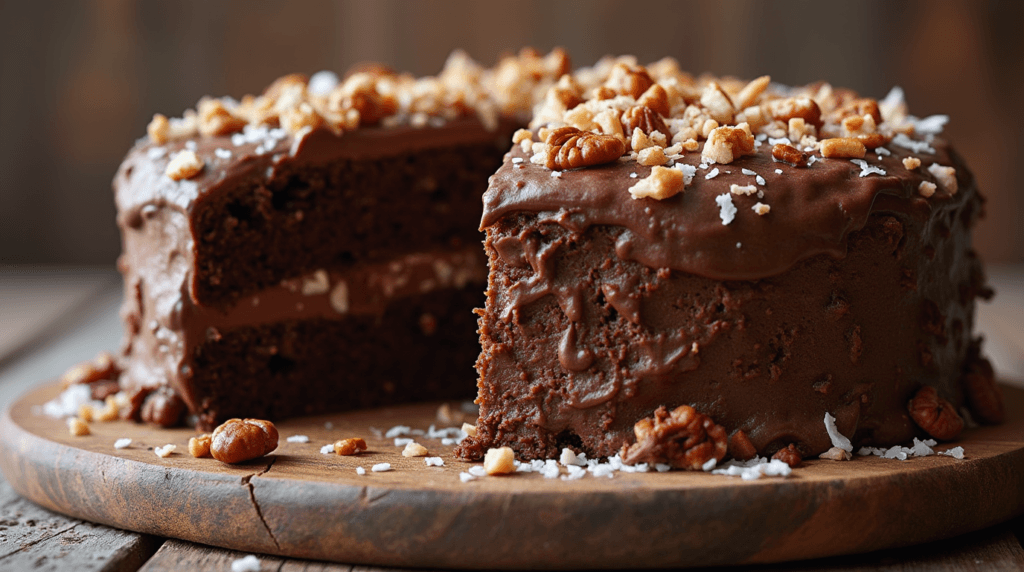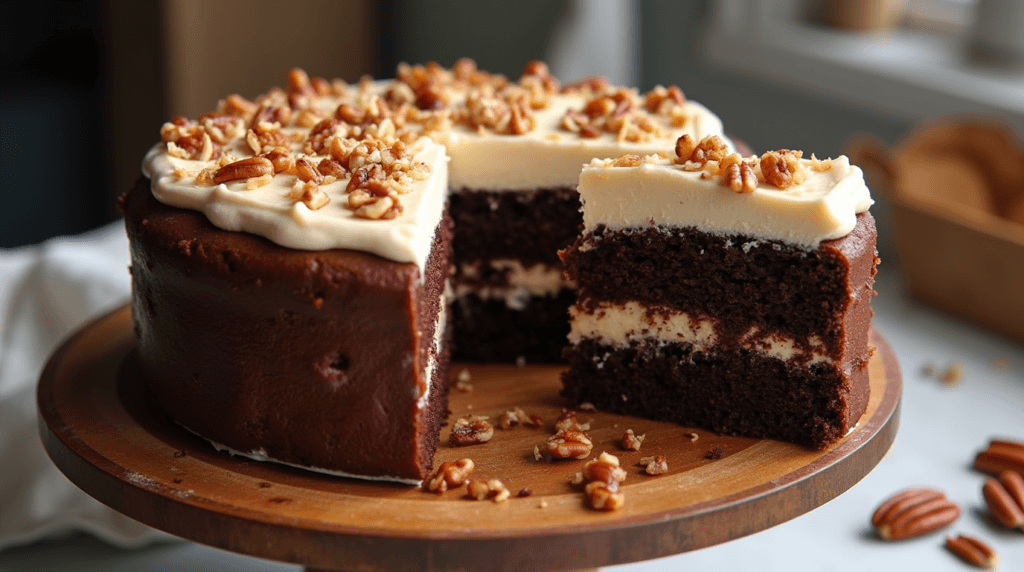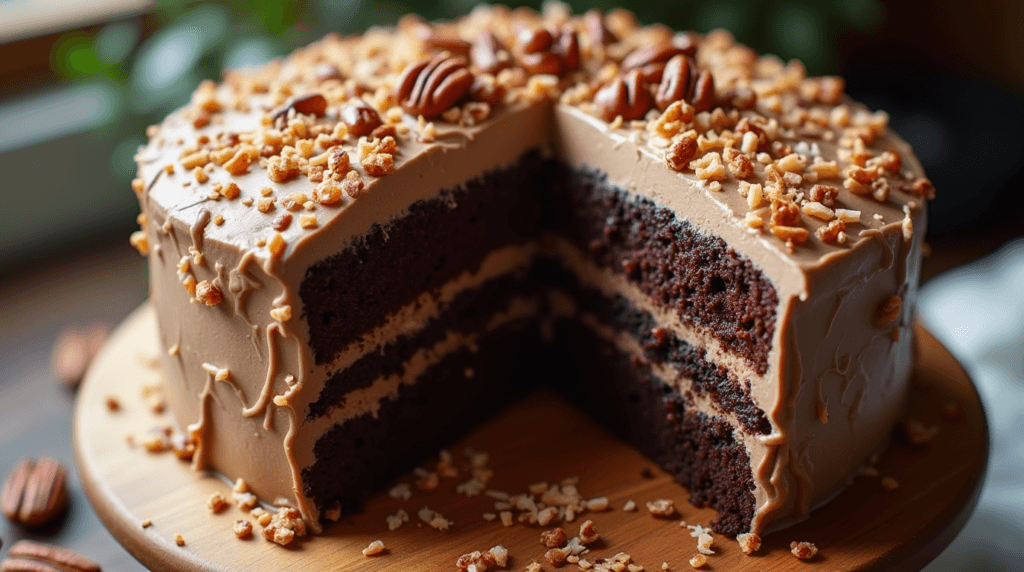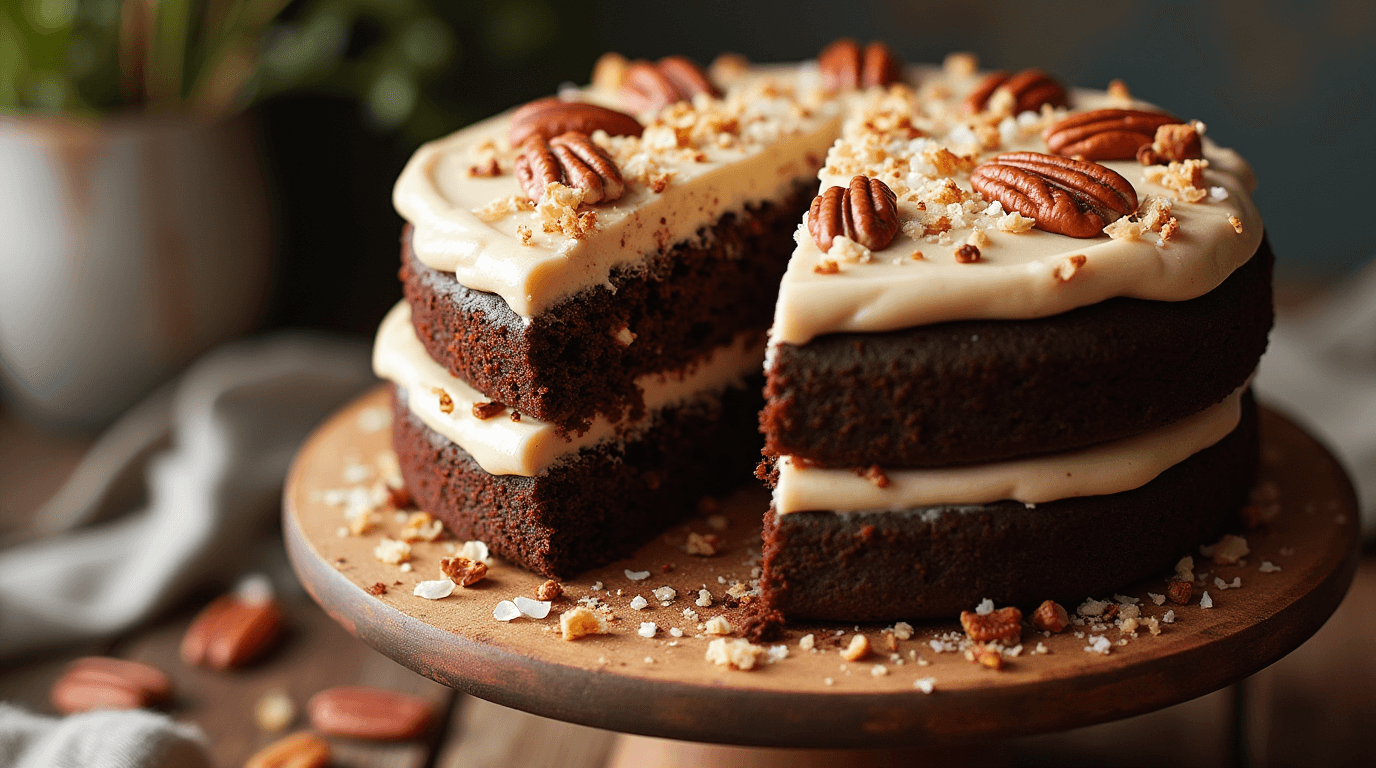If you’re a fan of decadent desserts, there’s nothing quite like a classic German chocolate cake. With its moist chocolate layers, rich coconut-pecan frosting, and melt-in-your-mouth texture, this cake has been a favorite for generations. Despite its name, German chocolate cake isn’t from Germany—it’s an American creation named after Samuel German, the chocolatier who developed the signature sweet baking chocolate used in the recipe.
This cake is the perfect centerpiece for birthdays, holidays, or any occasion that calls for something extraordinary. The combination of homemade frosting and tender chocolate cake creates a symphony of flavors that’s truly irresistible. In this blog post, we’ll walk you through a step-by-step guide to making this classic dessert from scratch, ensuring it turns out perfectly every time.
So grab your apron, preheat your oven, and let’s dive into this delightful German chocolate cake recipe that’s sure to impress family and friends alike!
Table of Contents
What Makes German Chocolate Cake Unique?
History of German Chocolate Cake
Despite its name, German chocolate cake doesn’t originate from Germany—it’s a uniquely American creation with a fascinating history. The cake gets its name not from a country but from Samuel German, an English-American chocolatier. In 1852, Samuel German developed a type of dark baking chocolate for the Baker’s Chocolate Company. His creation was a sweeter variety of chocolate that made it easier for bakers to incorporate rich chocolate flavors into their recipes. This chocolate was named “German’s Sweet Chocolate” in his honor.
Fast forward to 1957, when the cake as we know it today made its debut. A Texas homemaker named Mrs. George Clay submitted a recipe to a local newspaper in Dallas featuring German’s Sweet Chocolate as the star ingredient. Her recipe included layers of moist chocolate cake and a unique frosting made with shredded coconut, pecans, and evaporated milk. It was an instant hit, and readers across the country quickly embraced the dessert.
As the recipe gained popularity, the possessive apostrophe in “German’s Sweet Chocolate” was dropped, leading many to mistakenly associate the cake with the country of Germany. However, the dessert remains distinctly American in its origin and has become a beloved classic in Southern and American baking traditions.
Today, German chocolate cake is celebrated for its balance of sweetness and rich flavors, making it a timeless choice for special occasions. The combination of chocolate layers with the signature coconut-pecan frosting sets it apart from other chocolate cakes, giving it a unique place in the world of desserts.
This delicious cake’s history is a testament to the creativity of home bakers and the enduring appeal of rich, indulgent flavors. Whether you’re a fan of its history or simply love the taste, German chocolate cake remains a cherished recipe worth savoring.
Key Ingredients That Define the Flavor

The magic of a German chocolate cake lies in its unique combination of ingredients, each playing a vital role in creating the cake’s rich and indulgent flavor profile. From the moist chocolate layers to the iconic coconut-pecan frosting, every component contributes to its distinct character. Let’s dive deeper into the key ingredients that make this dessert so special:
1. German’s Sweet Chocolate
The signature chocolate used in a traditional German chocolate cake is German’s Sweet Chocolate, originally developed by Samuel German in the 1850s. This chocolate is sweeter than regular baking chocolate, which gives the cake a subtle sweetness without being overly bitter. While German’s Sweet Chocolate is the classic choice, bakers often substitute semi-sweet or dark chocolate for a more robust flavor if the original isn’t available.
2. Buttermilk
Buttermilk is a key ingredient in the cake batter that helps create the incredibly moist and tender texture German chocolate cake is known for. The slight tanginess of buttermilk complements the sweetness of the chocolate and enhances the overall flavor profile. For those without buttermilk on hand, mixing milk with a splash of lemon juice or vinegar works as a quick substitute.
3. Coconut
One of the most defining elements of a German chocolate cake is the shredded coconut used in the frosting. The coconut adds a chewy texture and a tropical sweetness that perfectly contrasts the richness of the chocolate. It’s an essential component of the cake’s signature coconut-pecan frosting and is what truly sets it apart from other chocolate cakes.
4. Pecans
The crunch of toasted pecans is another hallmark of German chocolate cake. Mixed into the frosting, they provide a nutty flavor and a delightful contrast to the cake’s soft layers. Pecans also enhance the frosting’s texture, adding a satisfying bite with every forkful.
5. Evaporated Milk
Evaporated milk is used to create the base for the frosting. When combined with sugar, egg yolks, and butter, it forms a creamy, caramel-like sauce that binds the shredded coconut and chopped pecans together. Its richness is key to the frosting’s luxurious texture and flavor.
6. Egg Yolks
The use of egg yolks in the frosting gives it a smooth, custard-like consistency. The yolks thicken the mixture as it cooks, creating a velvety texture that clings beautifully to the cake layers. They also add a subtle richness that enhances the overall flavor.
7. Vanilla Extract
A splash of vanilla extract rounds out the flavors of both the cake and the frosting. It adds a warm, aromatic note that ties together the sweetness of the chocolate, coconut, and pecans.
8. Unsweetened Cocoa Powder (Optional)
Some variations of the cake batter incorporate unsweetened cocoa powder to intensify the chocolate flavor. While not a traditional ingredient, it’s a great way to add depth for those who love a richer chocolate taste.
9. Butter
Butter is essential for both the cake batter and the frosting, adding a creamy, melt-in-your-mouth richness. In the frosting, it helps emulsify the ingredients, creating a smooth and cohesive texture.
10. Sugar
Sugar is used both in the cake batter and the frosting, striking the perfect balance between sweetness and the bitterness of the chocolate. Brown sugar is often used in the frosting for a hint of molasses flavor, complementing the coconut and pecans beautifully.
Bringing It All Together
When these ingredients are combined, they create a dessert that’s more than the sum of its parts. The balance of rich chocolate, sweet and nutty frosting, and tender cake layers ensures that every bite of German chocolate cake is a luxurious experience. Each component enhances the others, making this cake a true classic in the world of baking.
The Importance of Homemade Frosting
The coconut-pecan frosting is the heart and soul of a German chocolate cake. Unlike traditional frostings such as buttercream or ganache, this frosting is a cooked, custard-like mixture that adds a unique texture and flavor to the cake. While it might be tempting to use a store-bought version for convenience, making the frosting from scratch is crucial for achieving the authentic taste and texture that defines a true German chocolate cake.
1. Unmatched Freshness and Flavor
Homemade frosting delivers a level of freshness and depth of flavor that pre-made versions simply can’t replicate. The combination of toasted pecans and sweetened shredded coconut cooked in a rich caramel base creates a nuanced and indulgent topping that perfectly complements the cake’s chocolatey layers.
When made from scratch, the ingredients are cooked together just enough to blend their flavors while still maintaining distinct textures. The result is a frosting with a velvety, caramelized sweetness and the perfect balance of crunch from the pecans and chewiness from the coconut.
2. Customization Options
Making the frosting at home allows you to tailor it to your preferences. For example:
- Want more crunch? Add extra chopped pecans.
- Love the tropical notes? Increase the amount of shredded coconut.
- Prefer a deeper caramel flavor? Cook the evaporated milk and sugar mixture a little longer for a richer color and taste.
By controlling the ingredients, you can create a frosting that aligns perfectly with your taste preferences.
3. Preserving the Authentic Texture
Store-bought frostings often lack the authentic texture that makes the coconut-pecan frosting so unique. Homemade frosting achieves the ideal consistency—thick enough to hold its shape between cake layers but soft enough to spread easily. This texture is essential for the frosting to integrate seamlessly with the cake, creating a harmonious balance of flavors and mouthfeel.
4. A Rewarding Baking Experience
The process of making the frosting from scratch is not only rewarding but also surprisingly simple. Watching the sugar, butter, and evaporated milk transform into a luscious caramel base is a satisfying part of the baking journey. Adding the shredded coconut and toasted pecans gives the final touch, turning a few humble ingredients into an extraordinary topping.
This hands-on approach helps you connect with the recipe, making the final cake feel truly homemade and personal.
5. Better Quality Ingredients
Homemade frosting allows you to use high-quality, fresh ingredients, ensuring the best possible flavor. You can avoid the artificial flavors and preservatives often found in store-bought alternatives. Opting for high-quality butter, fresh pecans, and real vanilla extract elevates the frosting to a whole new level.
6. A Signature Touch for Your Cake
Making the frosting yourself ensures that your German chocolate cake stands out. It becomes a dessert that’s not just delicious but also a reflection of your effort and attention to detail. Guests and family members will notice the difference, and it adds a homemade charm that makes the cake even more special.
Step-by-Step Guide to Making a Classic German Chocolate Cake

Ingredients List
Before diving into the recipe, having a complete and well-organized ingredients list is crucial for ensuring a smooth baking process. The ingredients for a German chocolate cake are divided into two main components: the chocolate cake layers and the signature coconut-pecan frosting. Each ingredient plays a specific role in achieving the rich flavors and textures that define this classic dessert.
Ingredients for the Chocolate Cake Layers
- German’s Sweet Chocolate (4 ounces)
- This is the star ingredient for the cake, providing its unique, mildly sweet chocolate flavor. If unavailable, you can substitute with semi-sweet or dark chocolate, but for authenticity, German’s Sweet Chocolate is ideal.
- Boiling Water (1 cup)
- Used to melt the chocolate and create a smooth consistency. The heat helps to bring out the chocolate’s flavor and ensures it incorporates evenly into the batter.
- All-Purpose Flour (2 ½ cups)
- The base of the cake, providing structure. For a lighter texture, you can sift the flour before measuring.
- Baking Soda (1 teaspoon)
- Essential for leavening, ensuring the cake rises properly and has a tender crumb.
- Salt (½ teaspoon)
- Enhances the overall flavor by balancing the sweetness and chocolatey richness.
- Unsalted Butter (1 cup, softened)
- Adds richness and moisture to the cake while also helping to create a tender texture.
- Granulated Sugar (2 cups)
- Sweetens the cake and helps achieve a soft and moist crumb.
- Eggs (4 large)
- Provide structure and stability to the cake. They also help bind the ingredients together and contribute to its rich texture.
- Vanilla Extract (1 teaspoon)
- Adds a warm, aromatic flavor that enhances the chocolate. Always opt for pure vanilla extract for the best results.
- Buttermilk (1 cup)
- A key ingredient for moisture and flavor. The acidity in buttermilk reacts with the baking soda to create a soft, tender crumb.
Ingredients for the Coconut-Pecan Frosting
- Evaporated Milk (1 cup)
- Forms the creamy base for the frosting. Its rich, concentrated flavor is essential for achieving the frosting’s caramel-like taste.
- Granulated Sugar (1 cup)
- Sweetens the frosting and caramelizes during cooking, giving it a golden color and deliciously sweet flavor.
- Light Brown Sugar (½ cup, packed)
- Adds a subtle molasses flavor and enhances the frosting’s rich caramel taste.
- Egg Yolks (3 large)
- Thicken the frosting and contribute to its custard-like texture. Make sure to use fresh eggs for the best results.
- Unsalted Butter (½ cup, cubed)
- Adds richness and a silky texture to the frosting. The butter also helps to emulsify the ingredients.
- Vanilla Extract (1 teaspoon)
- Adds depth and rounds out the flavors in the frosting.
- Shredded Sweetened Coconut (1 ⅓ cups)
- The star ingredient of the frosting, providing a chewy texture and sweet tropical flavor.
- Chopped Pecans (1 cup, toasted)
- Adds crunch and a nutty flavor to the frosting. Toasting the pecans before adding them enhances their aroma and taste.
Optional Ingredients for Garnish
- Chocolate Shavings or Chips: For decoration and added chocolate flavor.
- Extra Toasted Pecans: For garnishing the top or sides of the cake.
- Whipped Cream: A dollop on the side can balance the richness of the cake.
Step 1: Preparing the Chocolate Cake Layers
The foundation of a German chocolate cake lies in its moist and tender chocolate layers. Achieving the perfect texture and flavor requires careful preparation and attention to detail. This step combines high-quality ingredients, precise measurements, and proper mixing techniques to create a rich, chocolatey base that complements the signature coconut-pecan frosting. Here’s how to prepare the chocolate cake layers step by step:
1. Preheat the Oven and Prepare the Pans
- Set the oven temperature to 350°F (175°C). This ensures an even baking environment for the cake layers.
- Prepare three 8- or 9-inch round cake pans by greasing them with butter or nonstick spray. Dust each pan lightly with flour, tapping out the excess. Alternatively, you can line the bottoms with parchment paper for easy removal after baking.
2. Melt the German’s Sweet Chocolate
- Break 4 ounces of German’s Sweet Chocolate into small pieces and place them in a heatproof bowl.
- Pour 1 cup of boiling water over the chocolate and let it sit for 2-3 minutes to soften.
- Stir the mixture until the chocolate is completely melted and smooth. Set it aside to cool slightly. This step ensures the chocolate blends seamlessly into the batter without curdling other ingredients.
3. Mix the Dry Ingredients
- In a medium bowl, sift together:
- 2 ½ cups all-purpose flour
- 1 teaspoon baking soda
- ½ teaspoon salt
- Sifting not only removes lumps but also aerates the flour, ensuring a lighter and more tender cake.
4. Cream the Butter and Sugar
- In a large mixing bowl, use an electric mixer to beat 1 cup softened unsalted butter until creamy and smooth.
- Gradually add 2 cups granulated sugar, beating on medium speed until the mixture is light and fluffy. This process usually takes 3-5 minutes and is crucial for incorporating air into the batter, resulting in a soft cake texture.
5. Add the Eggs
- Add 4 large eggs, one at a time, beating well after each addition. This ensures the eggs are fully incorporated and the batter remains smooth. Eggs provide structure to the cake and help bind the ingredients together.
6. Incorporate the Vanilla and Melted Chocolate
- Mix in 1 teaspoon vanilla extract to enhance the flavor.
- Slowly add the cooled melted chocolate, beating on low speed until fully combined. The batter will take on a rich, chocolatey color and aroma.
7. Alternate Adding Dry Ingredients and Buttermilk
- Gradually add the sifted dry ingredients to the batter in three additions, alternating with 1 cup buttermilk in two additions. Start and end with the dry ingredients.
- Mix on low speed after each addition, just until combined. Avoid overmixing, as this can lead to a dense cake. The buttermilk adds moisture and a slight tang, balancing the sweetness of the chocolate.
8. Divide and Smooth the Batter
- Evenly divide the batter among the prepared cake pans. Use a kitchen scale for precision if needed to ensure uniform layers.
- Smooth the tops with a spatula to create an even surface for baking.
9. Bake the Cake Layers
- Place the pans in the preheated oven and bake for 25-30 minutes, or until a toothpick inserted into the center of each cake comes out clean.
- Rotate the pans halfway through baking to ensure even cooking.
10. Cool the Cakes Completely
- Remove the pans from the oven and let them cool on a wire rack for about 10 minutes.
- Carefully run a knife around the edges of the pans to loosen the cakes, then invert them onto the wire rack.
- Peel off the parchment paper (if used) and allow the cakes to cool completely before assembling. Cooling is essential to prevent the frosting from melting when applied.
Step 2: Making the Coconut-Pecan Frosting
The coconut-pecan frosting is what truly sets a German chocolate cake apart from other chocolate cakes. This cooked frosting has a rich, custard-like consistency, filled with chewy coconut and crunchy toasted pecans. Making this frosting from scratch ensures the perfect blend of flavors and textures. Follow these detailed steps to create this iconic topping:
1. Gather Your Ingredients
Before you begin, make sure you have the following ingredients prepared:
- 1 cup evaporated milk
- 1 cup granulated sugar
- ½ cup light brown sugar (packed)
- 3 large egg yolks
- ½ cup unsalted butter (cut into cubes)
- 1 teaspoon vanilla extract
- 1 ⅓ cups sweetened shredded coconut
- 1 cup chopped pecans (toasted)
Toasting the pecans beforehand enhances their flavor and adds a nutty aroma to the frosting. Spread the pecans on a baking sheet and toast them in a 350°F (175°C) oven for 5–7 minutes, watching closely to prevent burning.
2. Cook the Base of the Frosting
- In a medium saucepan, combine the evaporated milk, granulated sugar, light brown sugar, and egg yolks. Whisk the mixture thoroughly until smooth and well-blended. The whisking ensures that the egg yolks are evenly incorporated, preventing them from curdling during cooking.
- Add the cubed butter to the saucepan but do not stir yet. The butter will melt as the mixture heats, contributing to the rich, creamy texture.
3. Heat and Thicken the Mixture
- Place the saucepan over medium heat and cook the mixture, stirring constantly with a heat-resistant spatula or wooden spoon. Continuous stirring is essential to prevent the egg yolks from scrambling and to ensure an even consistency.
- Cook until the mixture thickens and turns a pale golden color. This process typically takes 10–12 minutes. You’ll know the frosting is ready when it coats the back of your spoon or spatula and leaves a visible trail when you run your finger through it.
4. Add the Flavor and Texture
- Remove the saucepan from the heat and stir in the vanilla extract. The vanilla enhances the frosting’s flavor and adds warmth to the sweetness.
- Fold in the toasted pecans and shredded coconut until evenly distributed. These ingredients give the frosting its signature texture, combining crunch and chewiness in every bite.
5. Cool the Frosting
- Transfer the frosting to a clean bowl and let it cool to room temperature. As it cools, the frosting will thicken further, making it easier to spread between the cake layers. Stir occasionally to prevent a crust from forming on the surface.

Step 3: Assembling the Cake
Once the chocolate cake layers and coconut-pecan frosting are ready, it’s time to bring everything together and assemble your German chocolate cake. The assembly process may seem simple, but it’s an essential step in ensuring the cake looks beautiful and tastes even better. Proper layering and frosting techniques will ensure that each bite is filled with the perfect balance of rich chocolate and sweet, nutty coconut-pecan frosting. Here’s how to assemble your cake step by step:
1. Prepare Your Workspace
Before starting the assembly process, make sure you have a clean, flat workspace. Gather the following items:
- The cooled chocolate cake layers
- The cooled coconut-pecan frosting
- A cake stand or large plate for serving
- A serrated knife (for leveling the cake layers if necessary)
- An offset spatula or butter knife for spreading the frosting
2. Level the Cake Layers (Optional)
Sometimes, cake layers can rise unevenly in the oven, resulting in a domed top. To ensure your layers are level and stack neatly, follow these steps:
- Use a serrated knife to trim off the domed tops of the cake layers.
- Trim a thin layer off the top of each cake to make them flat and even, which will help the frosting adhere better and prevent the layers from sliding apart.
- Discard the trimmings (or save them for cake crumbs or other uses).
This step is optional but highly recommended if you want a professional-looking finished cake.
3. Place the First Cake Layer
- Begin by placing one of the cake layers in the center of your cake stand or serving plate.
- Make sure the layer is centered and level. If necessary, use a ruler or the edge of your cake pan to ensure it’s aligned.
4. Apply the First Layer of Frosting
- Using an offset spatula or a butter knife, take about 1 to 1 ½ cups of the coconut-pecan frosting and spread it evenly over the top of the first cake layer.
- Start from the center and gently spread the frosting toward the edges. Be sure to cover the entire surface with a thick layer, making sure the frosting stays within the edges of the cake.
5. Stack the Second Cake Layer
- Carefully place the second cake layer on top of the frosting, ensuring it’s centered and level.
- Press down lightly to ensure the layers adhere to each other, but be gentle to avoid crushing the cake.
6. Frost the Top and Sides of the Cake
- Repeat the frosting process on top of the second cake layer.
- Once the top is fully covered, begin applying frosting to the sides of the cake.
- You can spread the frosting around the sides evenly, using an offset spatula to smooth it out, or leave it more rustic for a homemade look.
- If the frosting starts to warm up or soften too much while spreading, chill the cake briefly in the fridge to firm up the frosting and make it easier to spread.
7. Create Decorative Patterns (Optional)
If you’re looking to add a decorative touch to your cake, consider the following options:
- Use the back of a spoon or small offset spatula to create a swirl pattern on the top or sides of the frosting.
- Pipe extra coconut-pecan frosting around the edges or along the top for a more elegant finish.
- Garnish the top of the cake with extra toasted pecans or a sprinkle of shaved chocolate for added texture and decoration.
8. Chill the Assembled Cake (Optional)
While not necessary, chilling the assembled cake for about 30 minutes can help set the frosting and give it a cleaner appearance when sliced. The cake will also be easier to cut, and the frosting will hold its shape better.
9. Slice and Serve
Once the cake is fully assembled and you’re happy with its appearance, it’s time to serve!
- Use a serrated knife to cut neat, even slices, wiping the knife clean between each cut for a sharp, clean edge.
- Serve the cake at room temperature for the best flavor and texture.
Conclusion
The German chocolate cake is more than just a dessert—it’s a celebration of rich flavors, textures, and history. From the tender, moist chocolate cake layers to the indulgent, nutty coconut-pecan frosting, each component of this cake contributes to its timeless appeal. By following the steps outlined, from preparing the cake layers to assembling the cake with care, you can create a truly delicious and impressive dessert that will leave a lasting impression on your guests.
This cake’s combination of sweet chocolate, chewy coconut, and crunchy toasted pecans is a harmonious balance that makes it a favorite for special occasions like birthdays, holidays, and celebrations. The process of making it from scratch may seem involved, but the results are well worth the effort. The layers of cake are perfectly complemented by the homemade frosting, creating a treat that’s rich, flavorful, and satisfying with every bite.
Whether you’re a seasoned baker or just starting, this German chocolate cake recipe provides a straightforward approach to crafting a decadent dessert. The step-by-step instructions, tips, and tricks help ensure that each stage—from mixing the batter to frosting the cake—is easy to follow and yields fantastic results. The importance of using quality ingredients, such as German’s sweet chocolate and fresh buttermilk, cannot be overstated, as these contribute to the cake’s signature taste and texture.
Beyond the satisfaction of baking such a classic treat, there’s also the enjoyment of sharing it with friends and family. The cake’s rich, comforting flavors evoke feelings of nostalgia and warmth, making it the perfect choice for any occasion where you want to impress and delight your guests.
As you savor a slice of German chocolate cake, remember that the love and attention you put into making it are reflected in its taste. So whether you’re making it for a special occasion or just to satisfy a craving for something decadent, this cake is sure to bring joy to your kitchen and your taste buds.
In the end, a homemade German chocolate cake is a true labor of love—one that’s worth every minute of effort. Enjoy the process, the result, and the delicious moments shared with those who get to experience the magic of this classic dessert!

